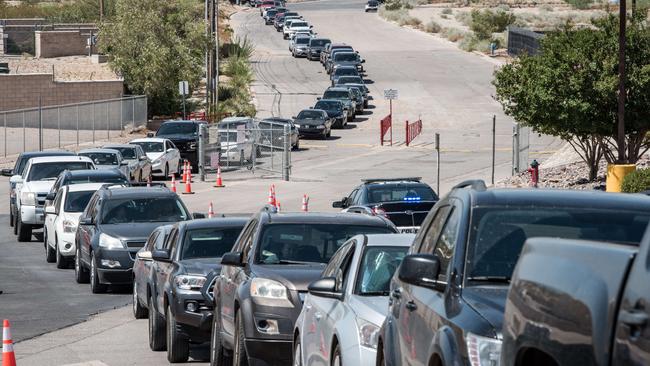Pace slows in America’s COVID-19 surge
New coronavirus cases in the US have risen by more than 60,000, the smallest daily increase in a week.

New coronavirus cases in the US have risen by more than 60,000, the smallest daily increase in a week.
But the surge that started in mid-June continues to put strain on healthcare systems in some parts of the country.
The total number of cases in the US exceeded 3.8 million on Tuesday, more than a quarter of the global tally, according to data compiled by Johns Hopkins University. The US death toll neared 141,000 out of more than 610,000 deaths recorded worldwide.
Several states that have seen coronavirus surges in recent weeks now appear to be seeing stark increases in coronavirus-related hospitalisations, according to data compiled by the Carlson School of Management at the University of Minnesota.
In the White House’s first coronavirus briefing in months, President Donald Trump defended the administration’s handling of the crisis and said the pandemic was “probably” going to get worse before it gets better.
Since the middle of June, when cases began to rise rapidly, states in the west and southwest of the US, including California, Nevada, Arizona and Texas, have seen a significant increase in the seven-day average of hospitalisations per 100,000 adults, according to the Carlson School’s latest data.
In the Midwest, new hospitalisations have largely declined or remained flat, and for several states in the northeast, seven-day averages have fallen for most of the summer. But in the southeast, many states are showing a steep increase, including Florida, Louisiana, Mississippi, Alabama and Georgia.
Hospitals in some states have been pushed to capacity, forced to transfer patients and running low on medical equipment and healthcare workers.
A clear picture of hospital strain is limited, however, by uneven public reporting across states and hospitals and by ad hoc efforts by federal officials to collect data since the pandemic began.
The absence of a federal strategy has forced states to come up with their own metrics, leading to inconsistency and an incomplete picture, said Tom Frieden, president and chief executive of Resolve to Save Lives, an initiative of non-profit Vital Strategies that published the list of metrics on Tuesday.
Mississippi State Health Officer Thomas Dobbs warned that the state’s health system was going to be thoroughly overwhelmed if there wasn’t a fall in transmission.
Tim Moore, chief executive and president of the Mississippi Hospital Association, said the state’s largest issue regarding capacity wasn’t beds, but limited staffing.
The pressure was compounded by the pandemic striking so many areas at once. Mr Moore said he had run hospitals for almost 30 years and it wasn’t uncommon for a hospital to send staff or ambulances to an area on the coast hit by a hurricane.
“That is really not doable in this scenario,” he said. “It’s so widespread.”
Coronavirus hospitalisations in Texas have jumped more than 20 per cent over the past two weeks, from 8698 on July 6 to 10,569 on Monday. The state, which has reported more than 332,400 cases of coronavirus, has about 1000 intensive care unit beds available in the state, according to data from the Texas Department of State Health Services.
Elsewhere, India reported 37,148 new cases on Tuesday, pushing the total number to more than 1.1 million, the country’s health ministry said. The death toll rose by 587 to 28,084.
Brazilian health authorities on Tuesday approved the inclusion of 1000 Brazilians in a clinical study of two vaccines against COVID-19, one produced by Pfizer and one produced by BioNTech. The vaccines will be tested on about 29,000 volunteers, including 1000 people in Brazil.
Brazil continues to struggle to control the pandemic, reporting 1367 deaths on Tuesday, bringing its toll to 81,487.
Mexico’s death toll broke 40,000. It reported its fourth-highest tally of deaths on Tuesday with 915 deaths, bringing its total to 40,400.
Iran reported a record daily number of deaths, registering 229 overnight. The total caseload in Iran, the hardest-hit country in the Middle East, now stands at 278,827 infections, including 14,634 deaths, after the country’s leaders gradually reopened the sanctions-bruised economy.
Health authorities in China reported eight new cases of local transmission in the far western region of Xinjiang. As of Monday, there were 55 confirmed cases in Xinjiang since a new wave of cases began last week.
The Wall Street Journal



To join the conversation, please log in. Don't have an account? Register
Join the conversation, you are commenting as Logout